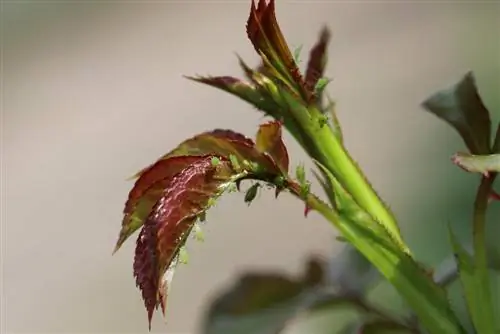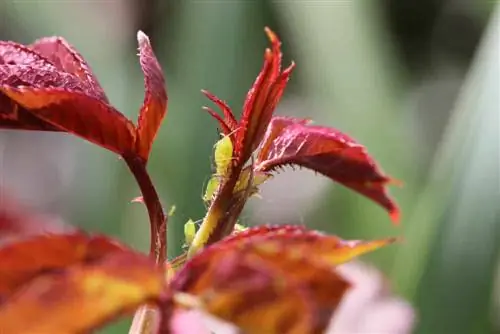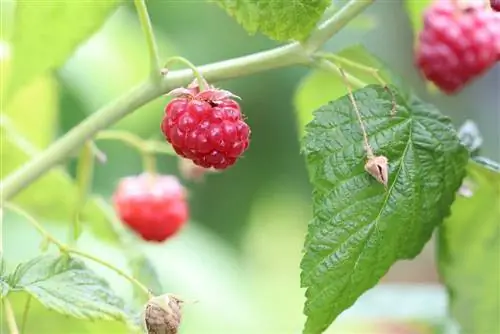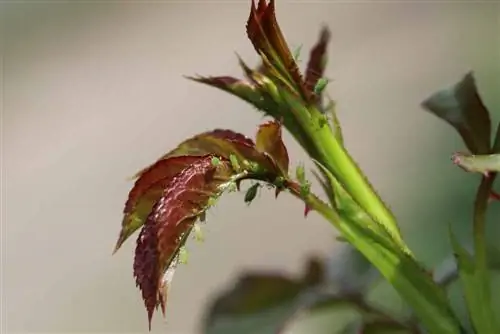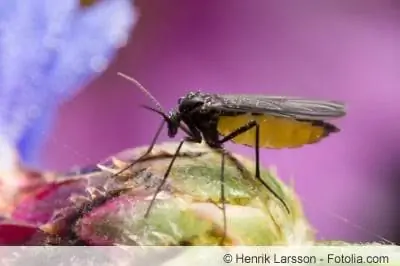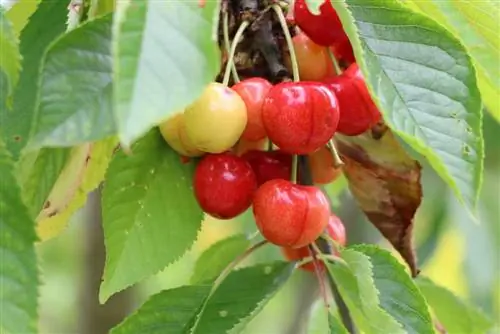- Author admin [email protected].
- Public 2023-12-17 03:39.
- Last modified 2025-06-01 06:48.
The little red, black or green pests are an important source of food for other animals such as birds and ladybirds, but they are a real torment on beloved plants on the windowsill, on the balcony or in the garden.
Damage caused by aphid infestation
When piercing, aphids inject their saliva into the plants. This leads to discoloration and bulging. With their proboscis, the aphids can specifically tap into the plant's pathways. This sucking activity causes stunting of the shoots. In extreme cases, entire areas can dry out and die. Sooty mold fungi often settle on the excreted honeydew (sticky, viscous mass), which gives the leaves a dirty appearance. Above all, aphids can transmit the dreaded viral plant disease. It is best to destroy the entire plant.
Aphid infestations can be recognized quickly and easily and can also be treated relatively simply and efficiently. Malformed and discolored leaves are typical of the infestation. But the point-shaped animals like the leaves as well as the rest of the plants: flower buds and shoot tips are real delicacies for them. Another unmistakable sign that aphids have made themselves at home on the plants is a sticky coating, known as honeydew, which can be found on the underside of the leaves. Although this is not a pest itself, it is a favorable breeding ground for black sooty mold fungi, which can seriously affect the plants.
The deformities of the leaves mentioned above are the result of an excretory product from the aphids. These suck the carbohydrate-rich plant sap out of the plant with their trunk and later excrete it as sticky honeydew.
Aphid control - gentle but efficient
Depending on the severity of the infestation, aphids can be eliminated using different means. Chemical treatment is avoidable in most cases, especially if you have a little patience. Quite a few home remedies promise good results, such as tobacco broth or curd soap lye. What all of these homemade remedies have in common, however, is that they do not have an immediate effect, but must be used regularly to ensure that the aphids are eliminated efficiently and completely. So if you're expecting a big blow against the little beasts, you'll be disappointed with home remedies. Their big advantages, however, are that they are usually gentle on plants and the environment and do not contain any chemical substances.
Home remedies for aphids
If the number of aphids is still manageable and the damage caused to the plant is not yet very severe, a powerful jet of water can do wonders. A houseplant can be easily treated in the shower or bathtub with a hard jet from the shower head. To do this, you should put them in a plastic bag that you tie tightly. Otherwise the bathroom quickly becomes a battlefield.
- If you have a garden, you can easily treat the infected plants with a garden hose. To do this, simply set the water jet as hard as possible and hose off the affected plants every few days - until no more louse can be found.
- Another home remedy is injections with broth: The herbs must be soaked for 24 hours, then brought to the boil and simmered for about 20 minutes. The broth can be made from tomato leaves and stems, as well as rhubarb leaves.
- For houseplants, it is sufficient to immerse the entire plant in lukewarm water for 24 hours. The aphids cannot survive this procedure.
- You can protect roses from aphids by planting lavender in the spaces or by sticking a clove of garlic close to each rose bush.
The classic aphid control agent is still soapy water. To do this, add 50 g of curd soap to one liter of water and dissolve it. Finally, about 75 ml of spirit is added to the solution. The result is applied to the plant using a spray bottle - but to the underside of the leaves. However, the mixture should not come into contact with the plant soil, so cover it well and do not expose the plant to direct sunlight after treatment.
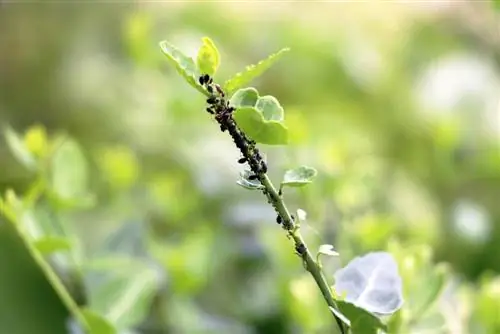
If the aphid infestation is already more advanced, the nettle decoction is recommended as a home remedy, which you can easily spray onto infected parts of the plant using a spray bottle. Here, too, the application must be repeated until the last louse has been killed. This can take a few days to weeks.
Another efficient remedy against pests is treatment with tobacco decoction. To do this, cigarette tobacco or stubbed cigarette butts are boiled in water until it turns a brownish color. After the brew has been strained, you can add a little more curd soap. Once the tobacco brew has cooled, it is diluted with water and sprayed onto the affected parts of the plant using a spray bottle. If curd soap has been added to the brew, the potting soil must be covered again and direct sunlight should be avoided after the treatment.
If the infestation is particularly severe, treatment with an emulsion made from neem oil (neem oil), which can be purchased from specialist retailers, is recommended. Severely affected plant parts should be removed.
The natural enemies of the aphid
Animals of the size of aphids obviously have many natural enemies. So they are a source of food from various other animals. These include birds and various beetles, but also lacewings, parasitic wasp larvae, ants and other types of insects. They are particularly popular with ladybugs and their larvae. A garden in which there is a good ecological balance will always harbor enough natural predators of aphids.
For this reason, some gardeners have developed a particularly proven method when they discover one or two aphids on the leaves of their ornamental plants: They then do - nothing. Very often it happens that the little pests do no real damage and disappear on their own at some point. As a hobby gardener, you of course have to decide for yourself whether you want to wait and drink tea or whether you would rather use one of the remedies presented above.
What you should know about aphid control in brief
- The aphid belongs to the plant lice family and is one of the best-known plant pests.
- Other common garden pests include snails, moles and voles.
- The adult aphid is approx. 1 to 4 mm large, winged or unwinged, and has two backward-pointing proboscis on the abdomen.
- The small, mainly green or black-brown animals prefer to attack young shoots, undersides of leaves and flowers.
If you discover aphids on your plants, you should first tackle them with home remedies. A good dose of patience and regular use are the keys to success in aphid control. The remedies presented above are all easy to use and efficient. In order to avoid aphid infestation in the first place, proper care of the plants is essential. He althy and strong plants are much less likely to be attacked by pests than sickly ones. It is therefore highly advisable to familiarize yourself with the individual requirements of your plants.
- Prevention: The best prevention is to introduce useful “enemies” such as ladybirds, earwigs, hoverflies, lacewings and parasitic wasps. Avoid dry air - aim for humidity, in the winter garden as well as in the glass greenhouse.
- Chemical control: Use fungicides. They penetrate the leaf and are absorbed by the pests through the plant sap.
- Biological control: Use pyrethrum, a proven remedy against sucking insects. Home remedies don't help immediately - only regular use brings success. Important: Don't wait until the plant is completely infested, but fight the pests early!

